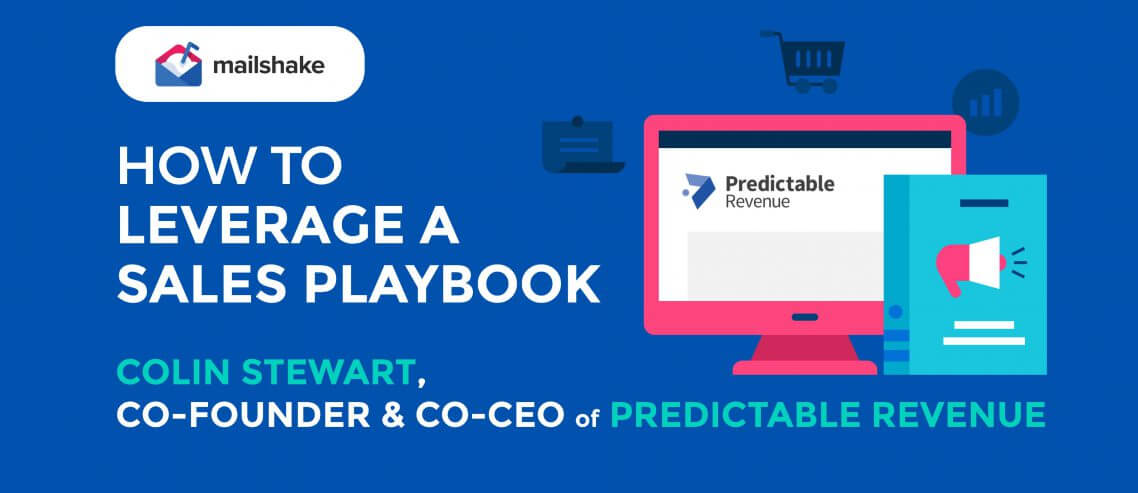How to Use a Sales Playbook to Train and Level Up Your Team

Contents
Salespeople tend to be naturally bullish. In such a high-pressure game, it’s practically a requirement.
Yet research shows that this self-confidence is often misplaced. In fact, only a quarter of salespeople exceeded their quota last year. That’s a pretty worrying statistic given the vital role that sales teams play in driving business growth.
What does this tell us? Clearly, the majority of salespeople still have plenty of room to improve – and one of the best ways to help them do this is by creating an effective sales playbook to guide their interactions with prospects.
Don’t have a sales playbook? Or perhaps you do have one, but you’re concerned that it’s not fit for purpose? Colin Stewart, Co-Founder & Co-CEO of Predictable Revenue, tells us how it should be done.
What Are the Building Blocks of a Useful Playbook? [1:12]
The word “useful” is super important here. It’s not just about creating a quality playbook – it’s about developing the processes to ensure that it reflects the day-to-day reality of your sales team. If it’s a million miles away from the practicalities of the job, or if salespeople are told to read it once and never shown it again, the whole exercise has been a waste of time. “It’s just a really fancy Google Doc that’s going to sit in Drive and grow cobwebs,” Colin notes.
Now, what are the critical elements of a sales playbook? According to Colin, there are two parts to this particular puzzle: the strategic side and the tactical side.
- The strategic side encompasses who your prospects are, what problems you’re solving for them, their pain points, and the customer stories that connect the dots.
- The tactical side is all about how you find and reach those prospects. How do you close them? What tools do you use? And what does your sales process look like?
The strategic side needs to come first, says Colin. “If you don’t nail that, the tactical stuff doesn’t really matter. If we’re trying to sell marketing automation software to farmers in Nebraska, they’re not going to want anything. This is the one area where I see a lot of companies are maybe missing a bit, where they can skimp.”
Who Owns the Sales Playbook? [3:45]
Colin says that ownership of the sales playbook falls on the shoulders of the CEO. “If you look at any organization, who owns core process within the company? It’s the CEO. So who’s responsible and accountable for making sure that people can do their jobs and remove blockers? It’s the CEO.”
This is the case regardless of business size, he insists: “Whether you’re a CEO who has a couple of Account Execs or a CEO who has VP, Director, Manager, I still think the CEO is responsible for making sure people have all that documentation.”
However, while the Chief Exec has ultimate responsibility, they’re going to need a little help along the way. With that in mind, Colin says the strategic side should be led by the senior team (under the guidance of the CEO), while the tactical side should be handled by the Director or Manager of Sales.
How Do Managers Use This to Train and Upskill Their Sales Team? [5:34]
As Colin explained previously, for a sales playbook to be effective, your sales team needs to truly understand it. In reality, there are two questions to answer here:
- How do we effectively onboard new salespeople?
- How do we keep the playbook fresh in their mind down the line?
In terms of onboarding, you need to have a plan covering the following key dates in a new salesperson’s lifetime with your company:
- First 30 days
- First 60 days
- First 90 days
- First 12 months
This should encompass specific goals and steps to help salespeople get there, Colin explains. “Usually that looks like who you’re going to talk to, who you need to shadow, watch these videos, read these books.”
At Predictive Revenue, Colin has developed a roughly 30-page document with links to around 100 pages of external reading. “Every week we get a new cohort of people, so we run a 90-minute training session where we run through one of the sections and then we leave some room for questions,” he says. “Each week is building on itself, and we’ll have tests and certifications that say ‘now you’ve gone through two of these sessions, answer some questions on this and let’s see how much you retained.’ You need to document it, teach it, then test to make sure they’ve retained it.”
How about ensuring that your sales playbook remains front-of-mind long after a salesperson has been through the onboarding process? It’s one thing to teach them how to do it, but if the daily, weekly or monthly actions of your frontline managers don’t reinforce the playbook, then any value will be quickly lost.
According to Colin, reinforcement is achieved through three steps:
- Regular one-on-ones, talking about where they are in their journey.
- Call reviews, where reps are told to bring their worst call from the last week and are given guidance on how to get better. “Don’t bring me your best call, this isn’t a chance to show off, I can see in your metrics you’re doing a good job,” Colin tells his team. “Bring me your worst and let’s figure out how we can improve something there.”
- Call scoring, where a couple calls a month are randomly reviewed, just as a check that salespeople aren’t bringing mediocre calls to the call review meetings and saying they’re the worst. “I want to have that trust, but I want to verify,” says Colin.
How Often Are You Updating the Playbook? [10:47]
You can’t expect to create a sales playbook that will still be relevant in a decade’s time; chances are it’ll need updating every so often. But how often?
It’s all about context, Colin says: “If you’re selling a commodity, you’re in a huge company, and your products and customers aren’t changing that frequently, then it’s probably going to be pretty steady state. [But] if you’re in a brand new startup, things are probably going to be changing on a day-to-day basis.”
As well as accommodating significant changes to your product or customer base, these updates should allow room for innovation. “I’m always in favor – no matter the size of the company – of always trying to get a bit better,” Colin explains. “I try to follow the 80:20 rule, where the majority of stuff I say is scripted, but every now and then I’m going to try something different. We hire smart people, we expect them to contribute and make small improvements along the way.”
These incremental gains should become apparent during your regular one-on-ones and call reviews. Perhaps a salesperson tried something new and it worked super well. Or maybe all your salespeople are finding that previously successful tactics have lost their edge. Use your existing processes as a feedback loop to build in improvements where necessary.





